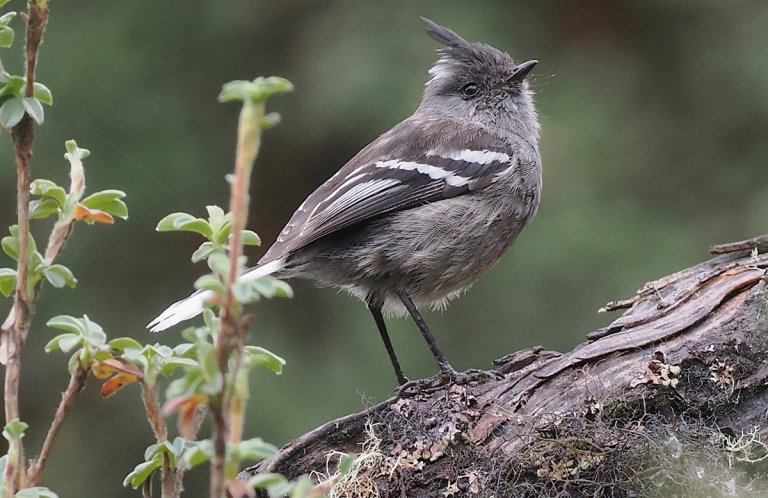
King Eider range: Breeding shown in yellow. Winter shown in blue. Map courtesy Cornell Lab of Ornithology.
The King Eider's species name spectabilis is Latin for “remarkable display,” referring to the drake, or adult male, in its breeding plumage. During that time, the drake is unmistakable, with powder-blue head and neck, light green cheek, orange-yellow frontal lobe outlined in black, and a red bill.
Ocean Adaptations
The King Eider's genus name Somateria gives a clue to how this bird can spend its winters in the coldest ocean waters. Somateria derives from the Greek words sōma, or “body,” and erion, which means “wool.” "Wool body" perfectly describes the thick layer of fluffy down found under the eider's tougher exterior plumage. These specialized feathers have a loose structure that traps air, helping the bird retain heat and maintain its buoyancy on the water.
Female eiders also use their down feathers to provide a warm lining for their nests. Humans value down for its superior insulating qualities and use it to stuff pillows and quilts.
Worldwide Eider
This eider may be found in polar regions around the Northern Hemisphere, sometimes in large flocks numbering up to 100,000 birds. The King Eider breeds in the high Arctic, including the Canadian Arctic, coastal Greenland, northern Alaska, and Siberia. During the winter, it is found along both U.S. coasts: On the Atlantic coast it may winter as far south as Virginia, and on North America's Pacific side, it winters on the southern Alaska coast and around the Aleutian archipelago.
Despite the fact that King Eiders have a very large range, there are no recognized subspecies.
Extreme Nest-Tending
King Eiders migrate to their breeding grounds in June and July and pair off at that time. Several males may court one female, surrounding her on the water. Breeding males sport “sails” on their backs — triangular peaks that form from the scapular feathers and give the appearance of two sharp fins sticking up from the folded wings. The males' displays include turning the head rapidly from side to side and rearing up out of water with flapping wings, accompanied by cooing calls.
Listen to a group of males displaying, with females calling in the background:
(Audio of King Eider by Andrew Spencer, 141727. Accessible at https://www.xeno-canto.org/141727)
After mating, the female builds her nest, a simple scrape on the ground, near a lake or other body of water. She lines the nest with grasses and down plucked from her breast, then lays three to seven eggs, which she incubates alone. Her brown-patterned plumage, radically different from the colorful plumage of the breeding male, provides effective camouflage. If an intruder approaches, the hen eider crouches low on her nest with head flattened on the ground, almost disappearing against the tundra backdrop.
Life on the Nest
The female eider sits tightly on her eggs and sometimes can be approached very closely. Females are so faithful to their nests that they sometimes go a week or more without feeding, and thus may lose significant amounts of weight while incubating.
King Eider chicks hatch covered in down and with eyes open. They are able to feed themselves immediately and often join with other broods in a crèche, which is attended by several adult females. Such “duck daycare” helps to protect chicks from gulls and other aerial predators. This strategy also allows other females to safely leave their young while they feed and recover weight lost during incubation. A similar crèche strategy is also used by other birds, including King and Macaroni Penguins.

King Eider pair. Rob Kempers/Shutterstock.
Clam-Diggers
King Eiders forage at sea during the winter daylight hours, diving deep underwater to depths of over 100 feet in search of shellfish, krill, and squid. They use their well-developed eyesight to locate food, then swallow it while still underwater. Like most diving ducks, the King Eider has evolved a large supraorbital process (analogous to a human brow bone) to protect its eyes and salt glands from injury as it forages on the ocean floor.
During the nesting season, when King Eiders switch to feeding in fresh water, they add other crustaceans, insects and their larvae, and plant material to their diets. Females and ducklings in particular consume many insects during the Arctic summer.
Troubles On (and Near) the Tundra
Like other Arctic-nesting bird species ranging from the Sanderling to the Peregrine Falcon, the King Eider is vulnerable to habitat loss, particularly that caused by climate change.
Because the King Eider spends so much time at sea, it is also vulnerable to oil spills, particularly as shipping and oil and gas exploration increases in areas with decreasing pack ice. Wind energy development and the nets of large-scale fisheries can also take a toll.
ABC has led efforts to establish Bird-Smart Wind Energy development, which includes siting turbines well away from bird migration corridors. We work to assess and advise on potential impacts of proposed projects, taking action if necessary in places vital for migratory birds, such as the Great Lakes.
Donate to support ABC's conservation mission!



















































